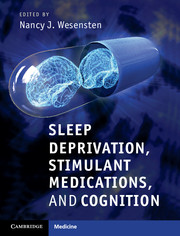Book contents
- Sleep Deprivation, Stimulant Medications, and Cognition
- Sleep Deprivation, Stimulant Medications, and Cognition
- Copyright page
- Contents
- Contributors
- Foreword: Sustaining cognitive performance: a modern imperative
- Preface
- Section 1 Basic Mechanisms: Cognitive Performance and Sleep
- Section 2 Stimulant Reversal of Cognitive Deficits
- Section 3 Alternatives for Sustaining Cognitive Performance During Sleep Loss
- Chapter 13 Light exposure for improving cognition during sleep loss and circadian misalignment
- Chapter 14 Nutritional countermeasures for cognitive performance decrements following sleep deprivation
- Chapter 15 The role of alertness monitoring in sustaining cognition during sleep loss
- Chapter 16 Sustaining neurobehavioral performance on less sleep: is SWS enhancement the key?
- Section 4 Summary and Conclusions
- Index
Chapter 16 - Sustaining neurobehavioral performance on less sleep: is SWS enhancement the key?
from Section 3 - Alternatives for Sustaining Cognitive Performance During Sleep Loss
Published online by Cambridge University Press: 05 September 2012
- Sleep Deprivation, Stimulant Medications, and Cognition
- Sleep Deprivation, Stimulant Medications, and Cognition
- Copyright page
- Contents
- Contributors
- Foreword: Sustaining cognitive performance: a modern imperative
- Preface
- Section 1 Basic Mechanisms: Cognitive Performance and Sleep
- Section 2 Stimulant Reversal of Cognitive Deficits
- Section 3 Alternatives for Sustaining Cognitive Performance During Sleep Loss
- Chapter 13 Light exposure for improving cognition during sleep loss and circadian misalignment
- Chapter 14 Nutritional countermeasures for cognitive performance decrements following sleep deprivation
- Chapter 15 The role of alertness monitoring in sustaining cognition during sleep loss
- Chapter 16 Sustaining neurobehavioral performance on less sleep: is SWS enhancement the key?
- Section 4 Summary and Conclusions
- Index
Summary
Keywords
- Type
- Chapter
- Information
- Sleep Deprivation, Stimulant Medications, and Cognition , pp. 223 - 236Publisher: Cambridge University PressPrint publication year: 2012

